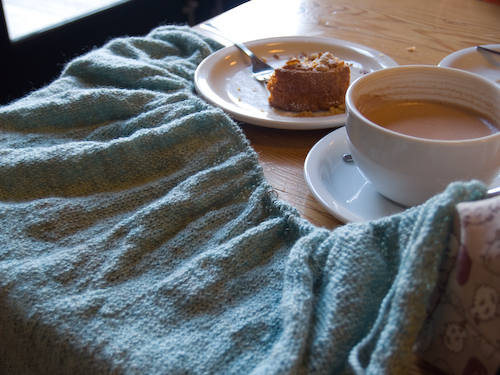Mr. G got a pair of fingerless gloves (actually a tweed set from this same pattern that I never Ravelled) for his birthday last year. He loved them. He wore them regularly. Alas, their little threesome eventually parted ways, as so often happens with gloves and their wearers. One glove struck off to make its fortune elsewhere and was never seen again. I told my husband I’d knit him a new pair, and he some ideas for improvements: a longer, snugger cuff. Short fingers. (I grimaced inwardly about the fingers, since they demand time and fiddliness out of all proportion to their total stitch count, but this is True Love, people. True Love doesn’t balk at fingers on gloves.)
I bought the yarn last March in Seattle at Acorn Street Yarn Shop, Rauma Finullgarn in a rich heathery brown with hints of red. (It matches Mr. G’s new beard.) I figured I’d make up the pattern as I went. Seed stitch rib for a handsome, not too clingy cuff, a variation on Ripple Stitch for the back of the hand.

I consulted with Katrin about the finger placement, as she is the reigning expert. Here’s the formula she suggested for setting up the fingers:
1. Divide the total number of stitches for the hand by 4.
2. Subtract 2 from the little finger and add them to the number for the pointer finger.
3. Put the stitches for the little finger on waste yarn, cast on 3 stitches to bridge between the little finger and the ring finger, and work two more rounds on the remaining stitches.
Then you work one finger at a time, putting the live stitches for the others on waste yarn and casting on 3 between fingers. Katrin’s reasoning for adding the stitches subtracted from the little finger to the pointer finger is that the pointer is your largest finger. She’s perfectly right. However, the middle two fingers are actually getting a total of 6 stitches added to their count because of the cast-on between fingers; the pointer and little fingers only get 3 added. So the pointer winds up at +5 while the middle and ring are both +6. So next time I might actually subtract a stitch each from the middle and ring fingers’ allotment to add to the pointer, too. It wouldn’t be missed on the palm side.

Obviously, we need photos of the gloves ON Birthday Man. He was napping when I took these, trying not to come down with the creeping crud. (Knock on wood, it seems to have worked.) Must remember to bring the gloves and the camera on Sunday when we make our usual stop for coffee after choir.






